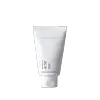What's inside
What's inside
 Key Ingredients
Key Ingredients

 Benefits
Benefits

 Concerns
Concerns

 Ingredients Side-by-side
Ingredients Side-by-side

Water
Skin ConditioningCocamidopropyl Betaine
CleansingSodium Methyl Oleoyl Taurate
CleansingPEG-75
HumectantAcrylates Copolymer
Glycerin
HumectantDisodium Cocoamphodipropionate
CleansingPEG-120 Methyl Glucose Dioleate
EmulsifyingDimethyl Sulfone
SolventPyridoxine Hcl
Skin ConditioningSalix Alba Bark Extract
AstringentForsythia Suspensa Fruit Extract
AntioxidantButylene Glycol
HumectantCentella Asiatica Extract
CleansingPolygonum Cuspidatum Root Extract
AntioxidantScutellaria Baicalensis Root Extract
AstringentCamellia Sinensis Leaf Extract
AntimicrobialGlycyrrhiza Uralensis Root Extract
Skin ConditioningChamomilla Recutita Flower Extract
MaskingRosmarinus Officinalis Leaf Extract
AntimicrobialSodium Chloride
MaskingCopper Tripeptide-1
Skin ConditioningAllantoin
Skin ConditioningCitric Acid
BufferingPotassium Hydroxide
BufferingSodium Benzoate
MaskingPhenoxyethanol
PreservativeDisodium EDTA
Water, Cocamidopropyl Betaine, Sodium Methyl Oleoyl Taurate, PEG-75, Acrylates Copolymer, Glycerin, Disodium Cocoamphodipropionate, PEG-120 Methyl Glucose Dioleate, Dimethyl Sulfone, Pyridoxine Hcl, Salix Alba Bark Extract, Forsythia Suspensa Fruit Extract, Butylene Glycol, Centella Asiatica Extract, Polygonum Cuspidatum Root Extract, Scutellaria Baicalensis Root Extract, Camellia Sinensis Leaf Extract, Glycyrrhiza Uralensis Root Extract, Chamomilla Recutita Flower Extract, Rosmarinus Officinalis Leaf Extract, Sodium Chloride, Copper Tripeptide-1, Allantoin, Citric Acid, Potassium Hydroxide, Sodium Benzoate, Phenoxyethanol, Disodium EDTA
Water
Skin ConditioningPotassium Cocoyl Glycinate
Glycerin
HumectantAcrylates Copolymer
Propanediol
SolventCoco-Glucoside
CleansingCocamidopropyl Betaine
CleansingGlycyrrhiza Uralensis Root Extract
Skin ConditioningKaolin
AbrasiveOldenlandia Diffusa Extract
Skin ConditioningHydrolyzed Ginseng Saponins
Skin ConditioningMorus Alba Root Extract
BleachingLilium Candidum Bulb Extract
Skin ConditioningHoney
HumectantNelumbo Nucifera Flower Extract
Skin ConditioningPolygonatum Officinale Rhizome/Root Extract
Skin ConditioningPanax Ginseng Root Extract
EmollientPaeonia Albiflora Root Extract
Skin ConditioningRehmannia Glutinosa Root Extract
Skin Conditioning1,2-Hexanediol
Skin ConditioningWater, Potassium Cocoyl Glycinate, Glycerin, Acrylates Copolymer, Propanediol, Coco-Glucoside, Cocamidopropyl Betaine, Glycyrrhiza Uralensis Root Extract, Kaolin, Oldenlandia Diffusa Extract, Hydrolyzed Ginseng Saponins, Morus Alba Root Extract, Lilium Candidum Bulb Extract, Honey, Nelumbo Nucifera Flower Extract, Polygonatum Officinale Rhizome/Root Extract, Panax Ginseng Root Extract, Paeonia Albiflora Root Extract, Rehmannia Glutinosa Root Extract, 1,2-Hexanediol
 Reviews
Reviews

Ingredients Explained
These ingredients are found in both products.
Ingredients higher up in an ingredient list are typically present in a larger amount.
Acrylates Copolymer is used as a film-forming agent and texture enhancer.
After applied, Acrylates Copolymer forms a thin film cover that helps skin feel more soft. It can help sunscreens become more water-resistant.
It is also used to make a product more thick.
Learn more about Acrylates CopolymerCocamidopropyl Betaine is a fatty acid created by mixing similar compounds in coconut oil and dimethylaminopropylamine, a compound with two amino groups.
This ingredient is a surfactant and cleanser. It helps gather the dirt, pollutants, and other impurities in your skin to be washed away. It also helps thicken a product and make the texture more creamy.
Being created from coconut oil means Cocamidopropyl Betaine is hydrating for the skin.
While Cocamidopropyl Betaine was believed to be an allergen, a study from 2012 disproved this. It found two compounds in unpure Cocamidopropyl Betaine to be the irritants: aminoamide and 3-dimethylaminopropylamine. High-grade and pure Cocamidopropyl Betaine did not induce allergic reactions during this study.
Learn more about Cocamidopropyl BetaineGlycerin is already naturally found in your skin. It helps moisturize and protect your skin.
A study from 2016 found glycerin to be more effective as a humectant than AHAs and hyaluronic acid.
As a humectant, it helps the skin stay hydrated by pulling moisture to your skin. The low molecular weight of glycerin allows it to pull moisture into the deeper layers of your skin.
Hydrated skin improves your skin barrier; Your skin barrier helps protect against irritants and bacteria.
Glycerin has also been found to have antimicrobial and antiviral properties. Due to these properties, glycerin is often used in wound and burn treatments.
In cosmetics, glycerin is usually derived from plants such as soybean or palm. However, it can also be sourced from animals, such as tallow or animal fat.
This ingredient is organic, colorless, odorless, and non-toxic.
Glycerin is the name for this ingredient in American English. British English uses Glycerol/Glycerine.
Learn more about GlycerinGlycyrrhiza Uralensis Root Extract comes from Chinese licorice. This plant is native to Asia and used in Chinese traditional medicine. Chinese licorice root contains antioxidants and polysaccharides.
Antioxidants may help with anti-aging by neutralizing free-radical molecules. Polysaccharides help moisturize the skin due to their ability to mimic our natural skin barrier.
Water. It's the most common cosmetic ingredient of all. You'll usually see it at the top of ingredient lists, meaning that it makes up the largest part of the product.
So why is it so popular? Water most often acts as a solvent - this means that it helps dissolve other ingredients into the formulation.
You'll also recognize water as that liquid we all need to stay alive. If you see this, drink a glass of water. Stay hydrated!
Learn more about Water